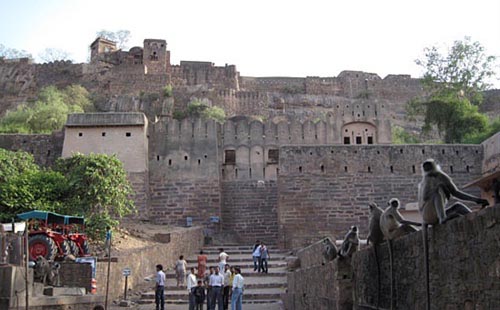Ranthambore Fort

Information on Ranthambore Fort (Sawai Madhopur, Rajasthan) - History & Architecture
Ranthambore Fort is a hilltop fort situated at Ranathambore Village, Sawai Madhopur District, Rajasthan State in India. This fort was built by the erstwhile rulers known as the Chauhan's in the 10th century AD. This fort has a long standing history as the gate way for the western part of India. This fort is located in a highly preserved bio diversity area in the midst of forest, mountains, rivers and lake that environed this cliff hanging fort.
Ranthambore Fort Architecture
Ranthambore Fort is built on a very though location on the merging point of the Vindhya and the Aravali mountain ranges. It is fledged around 7 KM of surface area on the top of Ranthambore. It stood around 200 meters above the sea level on a steep cliff. It is typical fort built in a traditional Rajputana architecture followed in those days. The rocks required to construct the fort was mined on the same area and later converted the pits in to a reservoir to fulfill water requirements inside the fort. These mined areas can be seen clearly in the summer seasons. It was built of these mined rock stones majorly along with lime stones and woods. This fort has got 7 major gates on its highly fortified walls. It had a very thick arched doors carved on woods and metals. On the inside there are many carved structures for court yard and palaces. The very important part is the Hindu and Jain temples constructed here. These are extremely crafted with cultural aspects of Hindu religion. The Vinayaka and the Shiva temple is the large built temple here. The completion of this fort work took more than a century. The later years saw many adding up of incredible structures and touch up activities by conquers of this fort. These were mainly adding up of sculptors and infrastructure activity within the fort areas.
Ranthambore Fort History
Ranthambore Fort is built in the year 944 AD by the great King Jayanth and followed by Rajput Chauhan in the year 1110 AD. This fort is believed to be built on the place where the first Sathi took place. Sathi is a customs of self immolation of women's on their death of their husbands, which were practiced in the ancient days. Traditionally it was a practice to built fort by human sacrifice or by burying the dead on its walls and structures to keep away from evil forces. It is also known s Juhar. This Juhar place was also chosen without any live sacrifice on its foundation time. It is believed by the historians that this place was a cremation ground previously. This palace name is chosen from the two villages which it was surrounded by, namely the Rana and the Thambore Village. These two names was put together and called by Ranthambore, when the fort took command from here. Hence the area name also famously known as Ranthambore in the Indian History. This fort location was a barrier to invade further to western area, from the north and the central areas. All an uddin Khilji, Islamic ruler of Delhi attempted to capture this fort in the year 1300 AD and went in vain. This fort was much important for trade and crossing towards the western Rajasthan by the Vindhya mountain Ranges. It has witnessed many battles from the Mughal rulers in the 17th century AD.
Ranthambore Fort Tourism Importance
Ranthambore Fort comes under the UNESCO site on behalf of preserving the world heritage monuments. To access this fort is like going for a trekking with natural scenic beauties around this fort. It is a tourist spot for history buffs. The largest wild reserve forest is also located here.
- Andaman Nicobar Monuments
- Andhra Pradesh Monuments
- Assam Monuments
- Bihar Monuments
- Chhattisgarh Monuments
- New Delhi Monuments
- Goa Monuments
- Gujarat Monuments
- Haryana Monuments
- Himachal Pradesh Monuments
- Jammu and Kashmir Monuments
- Karnataka Monuments
- Kerala Monuments
- Madhya Pradesh Monuments
- Maharashtra Monuments
- Odisha Monuments
- Punjab Monuments
- Rajasthan Monuments
- Tamil Nadu Monuments
- Telangana Monuments
- Uttar Pradesh Monuments
- West Bengal Monuments